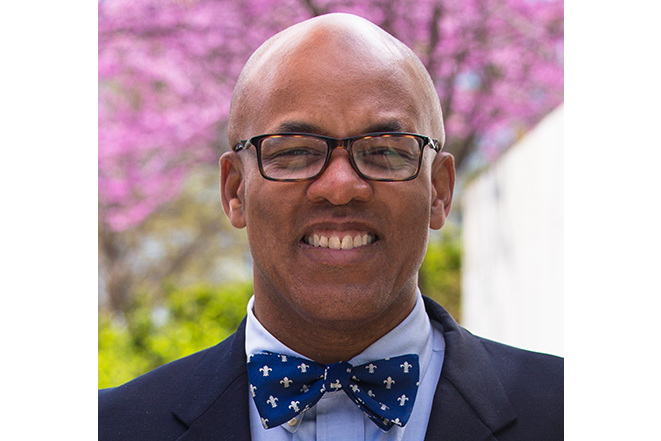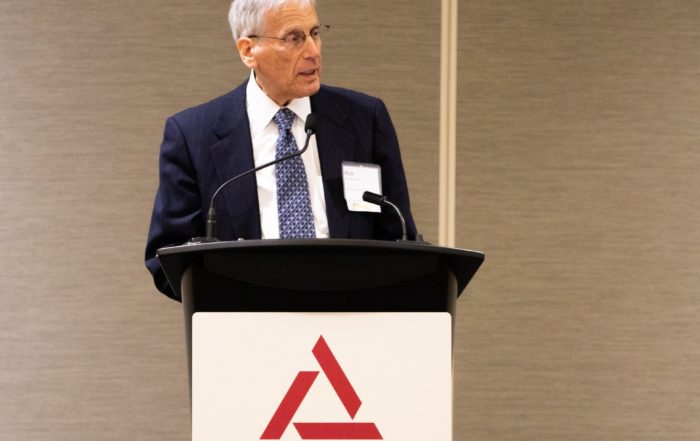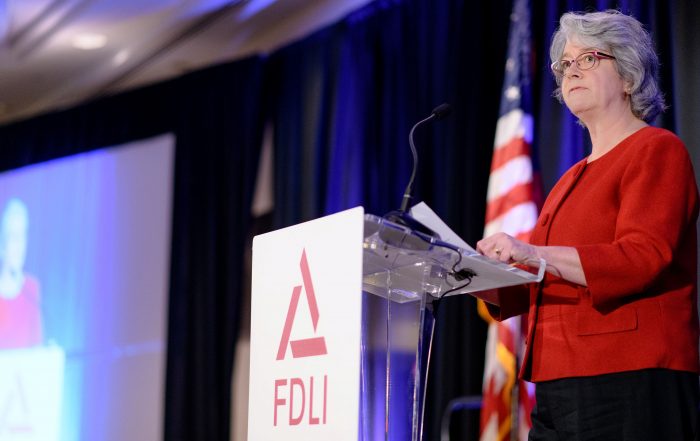Food and Drug Law Institute Tenth Annual Eric M. Blumberg Memorial Lecture
Senior Counsel, Covington & Burling LLP
December 7, 2023

Good afternoon, everyone. I am honored, and I mean honored, to present the lecture commemorating the life and the contributions of my good friend Rick Blumberg. I will begin my remarks by talking at some length about Rick and his contribution to FDA and to food and drug law more broadly. I am then going to give a brief overview of FDA enforcement for the last 117 years. I promise I won’t go year by year. And I will conclude with some personal remarks about FDLI.
But let me begin with Rick. Rick, as I think many of you know, was a graduate of Georgetown Law School, and he came from there in 1970 to the Office of Chief Counsel at FDA. When I became Chief Counsel a year later, he was the youngest member of my staff, and, more important, he was a hardcore litigator. That was what he came to FDA for. Now at that time, there was an unusual organizational structure within the Office of Chief Counsel. I found myself with 18 lawyers on my staff (it’s now 160, I might add), and they were all litigators. The only person, in those days, in OCC who talked to the Commissioner, the Bureau—now Center Directors—and the staff at FDA was the Chief Counsel him or herself. It took me about a day to change that, because my vision of FDA was to turn it into a modern administrative agency, not based solely on litigation. And I therefore divided the staff into basically two groups: one to provide daily regulatory advice to the Centers (I use the modern term), and the other to deal with the litigation, both against people that FDA brought cases, and on behalf of FDA when the agency was sued.
So I gave Rick the option: “What did you want, Rick? Did you want to have the daily contact with the agency, or the litigation?” Well, it took him a nanosecond to answer that question. From the beginning, he said, “I want to be out there enforcing the law, because without enforcement, in fact, there is no law.” And so that is exactly what Rick did for his entire career.
Now, at the same time he was making that decision, FDA was confronted with a major food insanitation issue. The FDA inspectors all over the country were finding that food warehouses were literally rat- and bird-infested, and that something had to be done. The head of ORA at that time, Sam Fine—who is one of my heroes, I might add—Sam said, he wanted to write a letter to every CEO, and say, “either clean up your act, or we at FDA are going to come after you.” So the letter was written to a hundred CEOs if I recall correctly.
Well, one of those letters went to a company and an individual who will go down in history. The company was Acme, and the individual was Mr. Park. FDA inspectors took a close look at three of the Acme warehouses and concluded they were literally infested with rats and birds, and as a result, a criminal indictment was launched against the company and against the individual, Mr. Park. The company didn’t make any pretense at defending. They immediately copped a plea. Mr. Park was personally offended and incensed—which, of course, is the purpose of having criminal liability—and he said, “I want a jury trial.” So the first question for me was, “Okay, what lawyer should I assign to litigate this case with the Department of Justice on behalf of FDA?” And there was one person: Rick Blumberg. Rick did the most extraordinary job—I’ve never told this story in public before—but Rick took on all of the work: of setting up all the witnesses, of compiling all the documentary evidence, including even photographs of the rats nibbling away at the food. It was just an extraordinary job.
Once we got to trial, Rick would call me every evening with a report about how things were going, and I have to tell you, they weren’t going well. Now, why was that? Because the federal district judge had the notion that criminal liability under the common law principles required—you can either use the Latin “mens rea and actus reas,” or you can use the English, “knowledge and intent.” And of course, that was not the position of FDA. When presented with the 1943 decision of the Supreme Court in the famous Dotterweich case, he just said it was wrongly decided and he wasn’t going to follow it. So Rick would call me and say, “Okay, Peter, what are we going to do?” To which I responded, “You’ve got to make sure that every scintilla of evidence you have dredged up gets into the record. It’s essential that we tell the world exactly how bad this place was.” And Rick got every bit of it in the record—was just a fantastic job at getting all the FDA inspectors to remember everything they had seen and how they had seen it and so forth.
So, when the case went to the jury, the judge said, “This is the worst thing I’ve ever seen.” Fortunately, the jury didn’t agree. The jury came back almost overnight and said, “Mr. Park, you are guilty on all five charges.” At that point, the judge was so angry—literally angry—that he fined Mr. Park $50 on each of the five cases, a total of $250. It was a remarkable thing, but we won the case. It went to the U.S. Court of Appeals, and they handed down a bad decision, so we were faced with the prospect of going to the Supreme Court. The Solicitor General didn’t like the case. The Assistant Solicitor General liked it even less. But I persisted, and the only argument that finally got traction was that you should not allow a federal district court judge and a U.S. court of appeals to overrule a Supreme Court decision. The case was therefore submitted to the Supreme Court.
Now, the story of that oral argument I’ve never told in public either, so you’re going to enjoy this. The Assistant Solicitor General—who I was sitting right next to at the podium in the Supreme Court—he got up at a podium like this, looked at the Court, and said, “Man, he got that far.” And the Supreme Court erupted, and said, “What are you doing? How could you possibly argue that it’s a crime if there’s no knowledge or intent?” We were lucky. We were lucky that he had gotten up five minutes before the lunch break at the Supreme Court. So he and I sat down for lunch—I will not try to repeat all he said to me about the case, because he had been against it from the beginning—but he said, “Okay Peter, what do you expect me to do now?” I said, “Well, do exactly what we’re all taught in law school. If the facts are bad, you argue the law. If the laws are bad, you argue the facts. You’re going to get up there and read the excerpts from the 483s. You’re going to read the descriptions given by the various FDA witnesses, and you’re going to then say to the Court, ‘Okay, do you want your food handled this way? Would you want your family to eat rat-infested food?’” And, needless to say, we won the case, six to three.
We never would have won that case without Rick Blumberg. Never. His preparation was a model of how a young lawyer puts their entire life into the preparation that is needed for an important case like that, and then, what was it that won the argument? It wasn’t citing Dotterweich. It was citing the findings of FDA during the three factory inspections. It was a fabulous decision for Rick. “Absolutely,” he said after that, “I will never do anything except enforcement.” And so, I just want you to all know how he achieved the state, if you will, of just fascination, of determination, and of putting everything in his life into enforcement of the Act.
Now I want to switch a little and talk about FDA enforcement over the ages, namely, as I said, 117 years. It started, of course, with the 1906 Federal Food and Drugs Act. That statute had two enforcement powers: civil seizure and criminal prosecution. There was no provision for injunctive reliefs or requirements. To understand what went on between 1906 and our present law of 1938, you have to go back and look at the resources available. I won’t give you the dollar amounts, because they’re meaningless in light of inflation, but I’m going to talk about the number of people that FDA had as employees—not all devoted to enforcement by a long shot. But if you go back to 1920, for example, the entire Food and Drug Administration consisted of 358 people for everything the agency did across the board. By ten years later, 1930, it was 593, and then 1940, which was two years after the 1938 Act, it got all the way up to 719. Think of that! That small number of people. Does everybody understand that now, today, FDA has 18,000 people to do that work? And they had less than 1,000 to undertake their work—not all of it by means focused on enforcement.
Then I began to think, “What was the country like at that time? How easy was it for those fewer than 1,000 people to do their job?” And particularly the field force, which had to go out and do the inspections and file all the legal documents. You start with the fact that there wasn’t a single paved road in the United States. There’s a famous story about an army convoy in 1919 that set out from Washington to prove that you could drive to San Francisco. There were 80 vehicles. All 80 of them broke down one way or another along the way. They got literally bogged down in the middle of Nebraska for a week or two. It took them 60 days to get across the country because there were no paved roads. And the average miles per hour, or the average number of days (it took them 60 days), that meant their average miles per hour was six.
These are the conditions that FDA faced when it was doing its 1906 enforcement. Not only that, think of the mail service in 1920 or 1930! It was totally unreliable. For the same reason the army trucks couldn’t get across the country, the mail couldn’t be delivered. Think also of telephones in, say, 1920 or 1930. When I was a young person, we still had a party line, where if you picked up the phone and wanted to call somebody, you would find somebody else already talking about something else. And my final one. I bet all of you who have children have taken your children to a museum and pointed out the antique typewriter. How anybody ever could type anything on that typewriter is beyond me at this stage. It was incredible the obstacles that FDA encountered. And then if they could use a typewriter, they had to use eight carbon copies, so if they made a single mistake on a page, they had to type the whole damn page all over again! These were the conditions.
We’ve seen the lack of resources, we’ve seen the difficulties of doing anything. Now, what are the enforcement statistics that FDA compiled? Between 1906 and 1938, they had a staggering 31,000 legal actions entered into the courts. That’s about 1,000 a year or about four a day. To this day, I cannot figure out how they did that. And I’m quite serious. I keep looking at figures like that and the extraordinary amount of work that those people did, and I wish I had known, you know, figured out these statistics when people were still alive who could explain how they did it, but I’ve never seen a story written about this. This is the greatest regulatory effort, not just in the history of this country, but in any country! Nobody has ever compiled these kinds of statistics. Of course, now it’s easy today. You search the web, you send a document out on the internet. That’s not what these people did. So it’s an extraordinary—absolutely incredible—history. Nobody at FDA knows these statistics, because I’ve asked people, and I wish that FDA would publish more of this history than they have, which is virtually nothing.
Let’s get up to 1938 now. How did FDA do in 1938? From 1938 to 1971, which is when I came, they had a pretty good record. For example, in 1950, they did 1,460 seizures. Think of that: 1,460! Compare that with the three to five they did last year. Three hundred and seventy-eight criminal prosecutions. In 1960, the first year I practiced food and drug law, they were still doing 1,000 seizures and 250 criminal actions, and my last year there, that was about what I did.
But things since then have changed, and I would like to offer four reasons why court enforcement has gone down and administrative law enforcement has increased. The first reason is quite simple: Beginning in 1958 with the Food Additives Amendment, enforcement was taken out of the courts, and it became part of the premarket review and approval process. And then, of course, there’s a cascade of statutes that continued that: the Color Additive Amendments of 1960; the Drug Amendments of 1962, which set up our modern system of regulating drugs; then the Medical Device Amendments of 1976. I could give 15 other statutes. The point is that you didn’t have to go to court to enforce because the people who reviewed applications in the agency did a form of administrative enforcement.
The second reason: guidance escalated. And again, guidance resolves issues that otherwise would have to be litigated in courts.
The third reason: when FDA in 1971 reinterpreted Section 701A of the statute, which previously for a hundred years had been interpreted as only permitting policy statements, and FDA in 1971 said, “No, no. This is substantive, binding rulemaking.” And, fortunately, the courts upheld that. But that changed it because all of the regulations, and all of those lengthy preambles, made it unnecessary to go to court to enforce FDA’s interpretation of the law.
And, the one you’re all familiar with: regulatory letters—warning letters—came along explicitly so the agency didn’t have to take any seizure actions, because they were usually minor in nature. The one that I hated most when I got there was that I was asked to bring seizure actions to enforce the requirement of the amount of white space on a food label that must surround the net quantity of contents. And to think that you’ve got to go to court to bring an action on that! So, you know, warning letters serve an incredibly useful administrative—not court-enforced—resolution of those kinds of issues.
But there’s one really major subject missing here, and that is criminal prosecution. Criminal prosecution is necessary because although 99% of industry wants to know what the law is—they want to read those preambles, they want to read the regulations, they want to understand—they don’t make money fighting the government. Those aren’t the people we’re worried about. What I’m talking about are the people who don’t care what the law is, they don’t want to know, and if they know, they’re going to violate it. For that, you can’t rely on those things I mentioned earlier. It’s a vast minority, because the vast majority comply.
But in 1991, FDA made the decision to take all criminal prosecution out of the hands of the field force and to set up a completely new Office of Criminal Investigation (OCI). It’s a siloed, separate group within FDA that has virtually no interaction with the field force. As a result, the field force—which knows the most about the law, and policy, and regulations, and the history of FDA—they are denied the one enforcement tool that is the strongest thing that could prevent real harm. That has now gone on for 30 years. I don’t criticize OCI at all. They were set up to do something totally different. The head of OCI, currently, got his training at the IRS, not at FDA. There’s never been someone in charge of the FDA field force who didn’t come up through the ranks.
But for OCI, I took a look: the address in the major cities where FDA has headquarters, the address for ORA is always different than the address for OCI. They’re in different buildings. They have different interests. OCI wants the big-ticket items, the big, important publicity items. The field force is out there to make sure that the country’s food and drug system runs the way it should.
The best example of how this does not work is the number of FDA pronouncements every week—indeed, sometimes more often—of the adulteration of dietary supplements, OTC drugs, and other consumer products with illegal prescription drug ingredients. There’s a massive amount of this type of illegal activity that goes on. The field force can’t deal with it because it has no authority under FDA current policy to bring criminal cases against that. OCI doesn’t have the capability, doesn’t have the history, doesn’t have a field force to back up warning letters. So, you have a situation where a year ago, a report was issued by a group that went out into the field and actually looked at how many of the companies who got a warning letter for this type of adulteration actually took their product off the market. One out of 30 took it off the market. The other 29 laughed at FDA. And all these people who are continuing to do it, for whom FDA sends out a press release—as if anybody’s going to read FDA press releases—all of that continues, and indeed, it’s getting worse. There’s just more and more of it.
How should we start addressing this problem? FDA should recognize that only the field has the historical knowledge, has the access, for example, to laboratories to evaluate adulteration of this type, and has the deep commitment to food and drug law. They should be given the authority to investigate this, because they could get rid of it quickly. For example, some of you may recall, there’s a provision in the Act: Section 305. It’s the shortest, and I think, one of the most powerful provisions in the statute. It says, “FDA shall give any person who they think is a problem, an order to show cause why they should not be criminally prosecuted.” This provision used to be a powerful enforcement technique. It has passed into total disuse. But I think everybody here who’s in private practice would agree with me: if you know a CEO who gets a 305 notice, that would be cleaned up overnight because the one thing they would want to do is avoid criminal prosecution. And there are other things that could be done, but only the field can do them, because they’ve got the people who can go out, find the problem, and then keep after the company with additional inspections in order to make sure that they comply. I hope FDA changes its policy in this respect. They are looking like fools.
Let me now turn to my concluding remarks. I have been a food and drug lawyer for my 64 years of private practice and FDA practice—my entire career—solely because of the Food and Drug Law Institute. If it weren’t for them, I would be a corporate lawyer back in my hometown of Buffalo, New York. I was all set to go back there, and my father happened to be in the food business. He kept asking me food-and-drug-law-type issues back in Buffalo. And so, in the fall of 1958, Bill Goodrich—as it turned out, my predecessor Chief Counsel at FDA—came to Harvard and gave a lecture on food and drug laws. And I said, “Great, I can ask him all my questions and get really great answers, definitive answers.” So I approached him, started asking—I think I had about 30—questions. And he said, “Wait a minute, Peter. You’re interested in this, aren’t you? Why don’t we have dinner?” Which, at the time I thought, “Why would he—this important person—want to have dinner with me? I just want my questions answered.” But, we had dinner, and at the end of it, he offered me the FDLI Fellowship to get a Masters in Food and Drug Law at NYU. And I will come back to this one central fact: if it weren’t for FDLI in those early years, there would not be the kind of thing we’re attending today. There would not be a robust food and drug law discipline that there is today.
So, I went there, and then, of course, I asked Bill, “Well, what am I going to do? Should I go back to Buffalo, or . . . .” He said, “No. Come and work with me!” And then, the man who became my mentor at Covington, who was senior at that time, Tommy Austern, he said, “Come with me!” And I went to Goodrich and said, “What do I do now?” And he said, “Don’t be a fool. You go to Covington, you become a partner, and then you’ll get a great government job.”
Well, I did what he asked. I said, “That’s a plan.” I went to Covington, became a partner, and on a Monday morning in 1971, I got a surprise call from Bill Goodrich in which he said, “Peter, I just retired. Do you want to take my job?” Usually, you don’t get a job that way. But all of this was because of, needless to say, the Food and Drug Law Institute.
I attended my first annual meeting of FDLI exactly 65 years ago, and I’m going to be at the 75th Anniversary this coming year. It’s only my 66th year, but I’m going to be there, and why? Because this is the one place that convenes the entire food and drug law bar. And I’m going to tell you what it was like 65 years ago. The meeting then consisted of about ten lawyers. I’m not kidding you. And they were the entire bar at that time. Food and drug law was this unknown, niche area. There was no group like this here today. How did that get transformed? Partly by the growth of FDA, but partly because FDLI all along that time built up the bar that exists today. Meetings like this are the one place you can be guaranteed to go, find all your colleagues, find leaders from FDA, from private industry, from the local bar, from consumer organizations. This is the only place. And it’s been that way all these years.
One final fact: when I took that fellowship—which was absolutely wonderful—there were only two law schools that taught food and drug law in the country: NYU and, of all places, University of Southern California Law School. Why? Because they were taught by FDA lawyers who were paid by FDLI to teach the courses. There was nothing until FDLI began doing things. They and I have the same objective all these years, and it’s informed my own choices of how I spend my time. I was determined that food and drug law would become a respected, widely recognized academic discipline that would be taught in law schools around the country, and because of FDLI, and my contributions alongside them, that that has become true.
So, I say to you in conclusion: first, never forget Rick Blumberg and his contribution to the law, and second, never forget the 75th Anniversary, and be there! Thank you.







